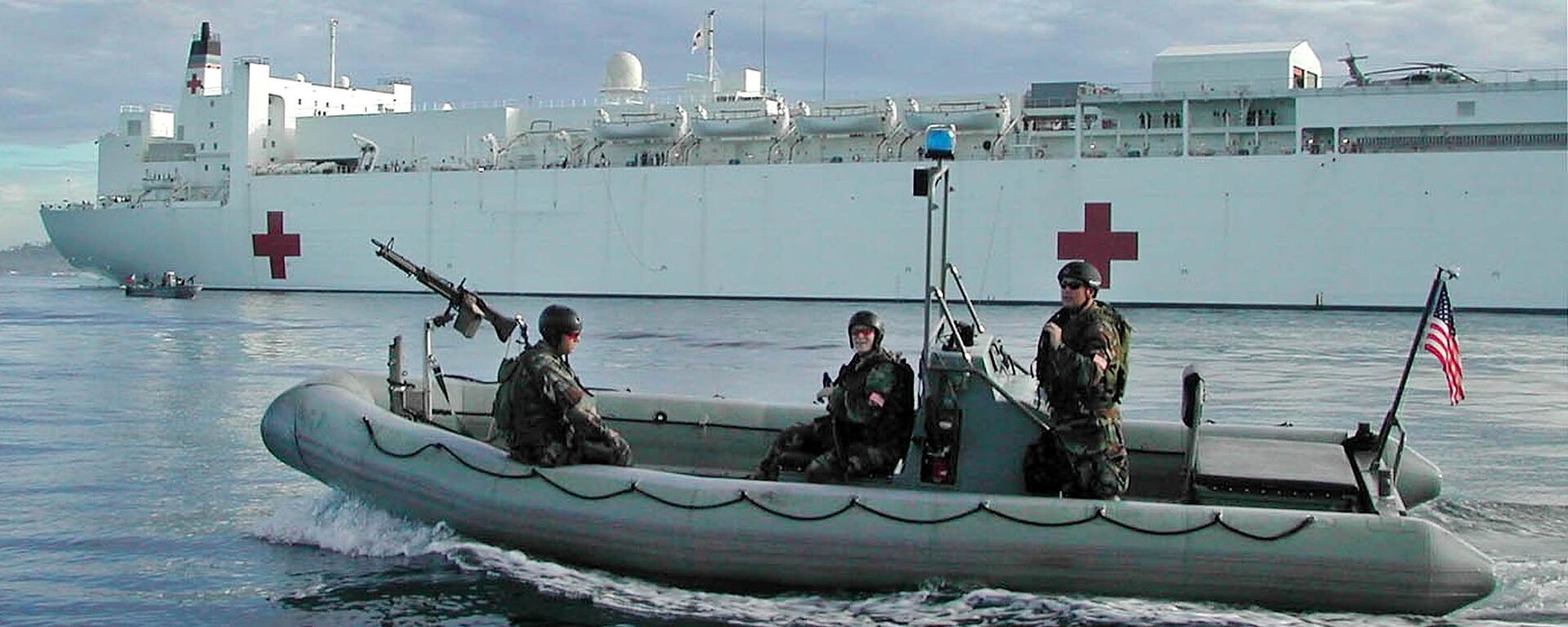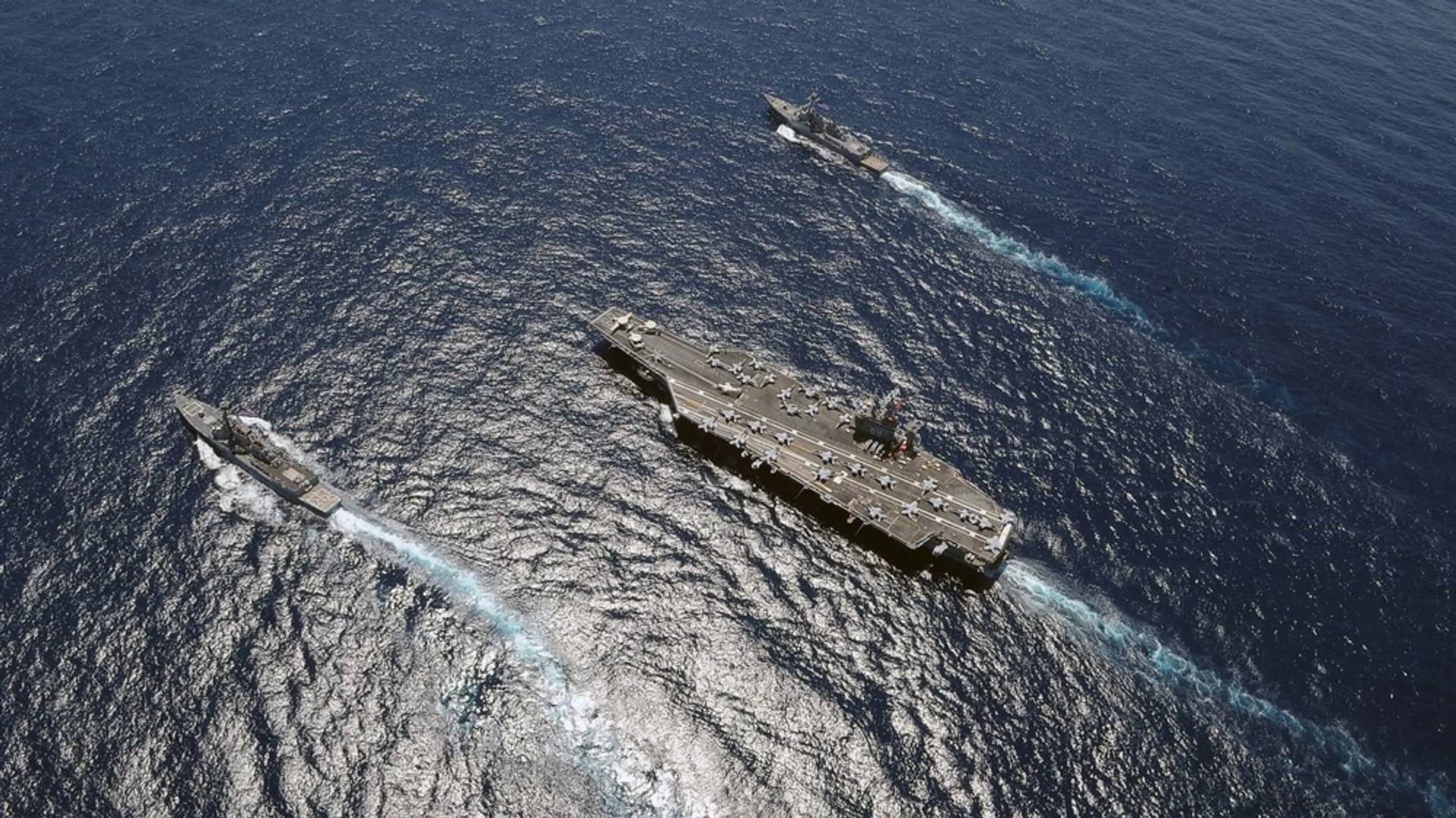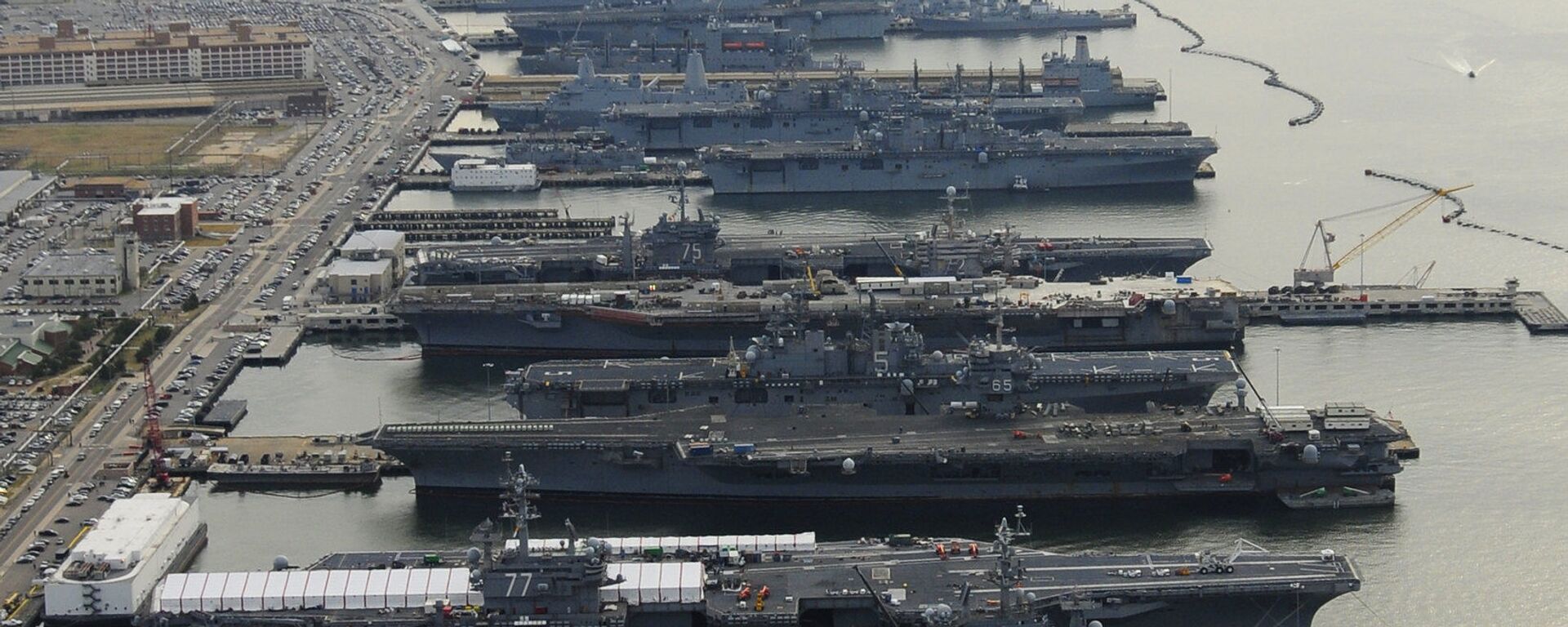https://sputnikglobe.com/20241022/houthi-missile-plunked-down-200-meters-from-us-supercarrier-in-red-sea-us-army-journal-reveals-1120644295.html
Houthi Missile Plunked Down 200 Meters From US Supercarrier in Red Sea, US Army Journal Reveals
Houthi Missile Plunked Down 200 Meters From US Supercarrier in Red Sea, US Army Journal Reveals
Sputnik International
A Houthi missile targeting the USS Dwight D. Eisenhower supercarrier landed just 200 meters from the warship this past June, an article in the October issue of West Point’s Combating Terrorism Center Sentinel journal by analysts from the Washington Institute for Near East Policy has revealed.
2024-10-22T18:08+0000
2024-10-22T18:08+0000
2024-10-22T18:08+0000
military
military & intelligence
us
red sea
israel
houthi
houthis
pentagon
anti-ship ballistic missiles (asbms)
uss dwight d. eisenhower
https://cdn1.img.sputnikglobe.com/img/07e8/03/1b/1117586527_0:50:999:611_1920x0_80_0_0_d7d21e12aa77461827c1d9a9e84ce579.png
A Houthi missile targeting the USS Dwight D. Eisenhower supercarrier landed just 200 meters from the warship this past June, an article in the October issue of West Point’s Combating Terrorism Center Sentinel journal by analysts from the Washington Institute for Near East Policy has revealed.“By achieving closer shadowing of target vessels…the Houthis appear to be reducing the time-in-flight limitation of their long-range strike systems (which can exceed 100 minutes for a drone flying 300 kilometers, during which time a ship can move by as much as 75 kilometers). Houthi missiles and drones may carry terminal guidance systems – certainly semi-active radar homing for anti-ship cruise missiles, also electro-optical cameras in UAVs, and possibly (though this is unconfirmed) some form of guidance system in some ASBMs as well,” the article said.The Eisenhower near-miss was at least the second time a US warship was nearly set alight by a Houthi projectile, the article said, pointing to a previously reported January 2024 incident involving the USS Gravely guided missile destroyer.US military officials, including USS Eisenhower Captain Christopher Hill have repeatedly and nonchalantly dismissed Houthi reports on the targeting of American warships, giving media press tours and providing photos and videos to show that the ships are safe and sound.But a string of reports have pointed to the potential cracks in the US naval armada’s powerful armor, with a Military.com report from June warning that “fatigue [was] setting in” aboard the Eisenhower strike group as it waged what was described as “the most intense running sea battle since World War II.”USS Laboon destroyer Captain Eric Blomberg hinted in an AP interview the same month about the risks Houthi missiles pose to American warships. “I don’t think people really understand just kind of how deadly serious it is what we’re doing and how under threat the ships continue to be,” he said. “We only have to get it wrong once. The Houthis just have to get one [missile] through.”The Eisenhower ended its deployment in the region the same month and headed to its home port in Norfolk, Virginia, replaced by the USS Theodore Roosevelt in July, and itself relieved by the USS Abraham Lincoln in September.US media have speculated on the risks posed to US carriers by Houthi attacks. “Despite the aircraft carrier’s formidable defenses and advanced technology, the persistence of Houthi harassment has sparked debates about the vulnerability of such vessels in modern combat environments, especially when facing unconventional threats from non-state actors like the Houthis,” a piece published in the National Interest in August said.In July, in a report entitled ‘How Many Missiles Does It Really Take To Sink A Supercarrier?’ Forbes urged cocky observers to “take a closer look at the facts before writing off the threat” posed by the Yemeni militia. “It seems highly unlikely that the Houthis will damage any US carrier. But history has repeatedly shown that defensive measures which look unbeatable on paper can fail due to human error…Confidence is justified, complacency is not. And moving even the mightiest carrier into an area where it may be attacked is not without risk,” the article stressed.The US has spent over $22 billion on the conflict in the Middle East which began on October 7, 2023, over $2.5 billion of that on the deployment of warships and aircraft fighting the Houthis. But the campaign has yet to bear fruit, with the militia seemingly only improving the accuracy and deadliness of their arsenal over time. In July, a Houthi airplane-style drone slammed into a building just 100 meters from the US Consulate in Tel Aviv, killing one person and injuring several others. Earlier this month, Israel reported bringing down a Houthi missile over central Israel using its Arrow defenses after the projectile apparently evaded perimeter defenses.
https://sputnikglobe.com/20241021/dem-rep-demands-tougher-sanctions-as-houthis-threaten-us-with-quagmire-worse-than-hell-of-vietnam-1120627905.html
https://sputnikglobe.com/20240803/us-media-warns-about-houthi-threat-to-aircraft-carriers-as-tensions-boil-over-in-red-sea-1119627453.html
https://sputnikglobe.com/20241013/deficiencies-gaps-and-inconsistencies-navy-seals-floundering-raid-on-houthi-vessel-revealed-1120527314.html
red sea
israel
Sputnik International
feedback@sputniknews.com
+74956456601
MIA „Rossiya Segodnya“
2024
News
en_EN
Sputnik International
feedback@sputniknews.com
+74956456601
MIA „Rossiya Segodnya“
Sputnik International
feedback@sputniknews.com
+74956456601
MIA „Rossiya Segodnya“
can houthis hit us aircraft carriers, are houthis dangerous to us navy, why can't us stop the houthis, why can't the houthis be stopped
can houthis hit us aircraft carriers, are houthis dangerous to us navy, why can't us stop the houthis, why can't the houthis be stopped
Houthi Missile Plunked Down 200 Meters From US Supercarrier in Red Sea, US Army Journal Reveals
The armada of US warships assembled in the Red Sea in late 2023 to stymie Houthi missile and drone attacks on Israeli-linked merchant shipping has yet to achieve results, with the Pentagon seemingly unable to achieve its aim of “degrading” the Yemeni militia’s capabilities, and US bombings only provoking the Houthis into ramping up their campaign.
A Houthi missile targeting the USS Dwight D. Eisenhower supercarrier landed just 200 meters from the warship this past June, an article in the October issue of West Point’s Combating Terrorism Center Sentinel journal by analysts from the Washington Institute for Near East Policy has revealed.
“By some accounts, an [anti-ship ballistic missile] or other missile arrived at a very shallow trajectory, with minimal warning, without a chance for interception, and splash[ed] down around 200 meters from the Eisenhower,” the
article said in a section analyzing the tools and capabilities at the Houthis disposal to maintain a lock on targeted ships.
“By achieving closer shadowing of target vessels…the Houthis appear to be reducing the time-in-flight limitation of their long-range strike systems (which can exceed 100 minutes for a drone flying 300 kilometers, during which time a ship can move by as much as 75 kilometers). Houthi missiles and drones may carry terminal guidance systems – certainly semi-active radar homing for anti-ship cruise missiles, also electro-optical cameras in UAVs, and possibly (though this is unconfirmed) some form of guidance system in some ASBMs as well,” the article said.
“The combination of wide-area surveillance, close-in target shadowing, and terminal guidance has allowed the Houthis to achieve some impressive feats of marksmanship, such as an apparent near-miss on a US aircraft carrier and a number of hits or very close misses by ASBMs on ships approximately 150-200 kilometers from launch points,” the piece added.
The Eisenhower near-miss was at least the second time a US warship was nearly set alight by a Houthi projectile, the article said, pointing to a
previously reported January 2024 incident involving the USS Gravely guided missile destroyer.
In that episode, “an enemy missile elud[ed] two layers of defense and [was] only…intercepted by the ship’s last-line-of-defense Close-In Weapons System,” the analysis said.
![A supporter of Yemen's Shiite Houthi rebels, wears a bandana with with an Arabic inscription that reads, at your service [Imam] Hussein, as he attends festivities marking the holy day of Ashoura, in Sanaa, Yemen, Thursday, Aug. 19, 2021. A supporter of Yemen's Shiite Houthi rebels, wears a bandana with with an Arabic inscription that reads, at your service [Imam] Hussein, as he attends festivities marking the holy day of Ashoura, in Sanaa, Yemen, Thursday, Aug. 19, 2021. - Sputnik International, 1920, 21.10.2024](https://cdn1.img.sputnikglobe.com/img/07e8/09/1b/1120321088_0:410:3072:1639_1920x0_80_0_0_146faccc1d4cdb2d0375089465d27105.jpg)
21 October 2024, 19:01 GMT
US military officials, including USS Eisenhower Captain Christopher Hill have repeatedly and nonchalantly dismissed Houthi reports on the targeting of American warships, giving media press tours and providing photos and videos to show that the ships are safe and sound.
But a string of reports have pointed to the potential cracks in the US naval armada’s powerful armor, with a Military.com
report from June warning that “fatigue [was] setting in” aboard the Eisenhower strike group as it waged what was described as “the most intense running sea battle since World War II.”
USS Laboon destroyer Captain Eric Blomberg
hinted in an AP interview the same month about the risks Houthi missiles pose to American warships. “I don’t think people really understand just kind of how deadly serious it is what we’re doing and how under threat the ships continue to be,” he said. “We only have to get it wrong once. The Houthis just have to get one [missile] through.”
The Eisenhower ended its deployment in the region the same month and headed to its home port in Norfolk, Virginia, replaced by the USS Theodore Roosevelt in July, and itself relieved by the USS Abraham Lincoln in September.
US media have speculated on the risks posed to US carriers by Houthi attacks. “Despite the aircraft carrier’s formidable defenses and advanced technology, the persistence of Houthi harassment has sparked debates about the vulnerability of such vessels in modern combat environments, especially when facing unconventional threats from non-state actors like the Houthis,” a
piece published in the National Interest in August said.
In July, in a report entitled ‘How Many Missiles Does It Really Take To Sink A Supercarrier?’ Forbes urged cocky observers to “take a closer look at the facts before writing off the threat” posed by the Yemeni militia. “It seems highly unlikely that the Houthis will damage any US carrier. But history has repeatedly shown that defensive measures which look unbeatable on paper can fail due to human error…Confidence is justified, complacency is not. And moving even the mightiest carrier into an area where it may be attacked is not without risk,” the article
stressed.
The US has spent
over $22 billion on the conflict in the Middle East which began on October 7, 2023, over $2.5 billion of that on the deployment of warships and aircraft fighting the Houthis. But the campaign has yet to bear fruit, with the militia seemingly only improving the accuracy and deadliness of their arsenal over time. In July, a Houthi airplane-style drone slammed into a building just 100 meters from the US Consulate in Tel Aviv, killing one person and injuring several others. Earlier this month, Israel reported bringing down a Houthi missile over central Israel using its Arrow defenses after the projectile
apparently evaded perimeter defenses.

13 October 2024, 03:05 GMT

![A supporter of Yemen's Shiite Houthi rebels, wears a bandana with with an Arabic inscription that reads, at your service [Imam] Hussein, as he attends festivities marking the holy day of Ashoura, in Sanaa, Yemen, Thursday, Aug. 19, 2021. A supporter of Yemen's Shiite Houthi rebels, wears a bandana with with an Arabic inscription that reads, at your service [Imam] Hussein, as he attends festivities marking the holy day of Ashoura, in Sanaa, Yemen, Thursday, Aug. 19, 2021. - Sputnik International, 1920, 21.10.2024](https://cdn1.img.sputnikglobe.com/img/07e8/09/1b/1120321088_0:410:3072:1639_1920x0_80_0_0_146faccc1d4cdb2d0375089465d27105.jpg)



